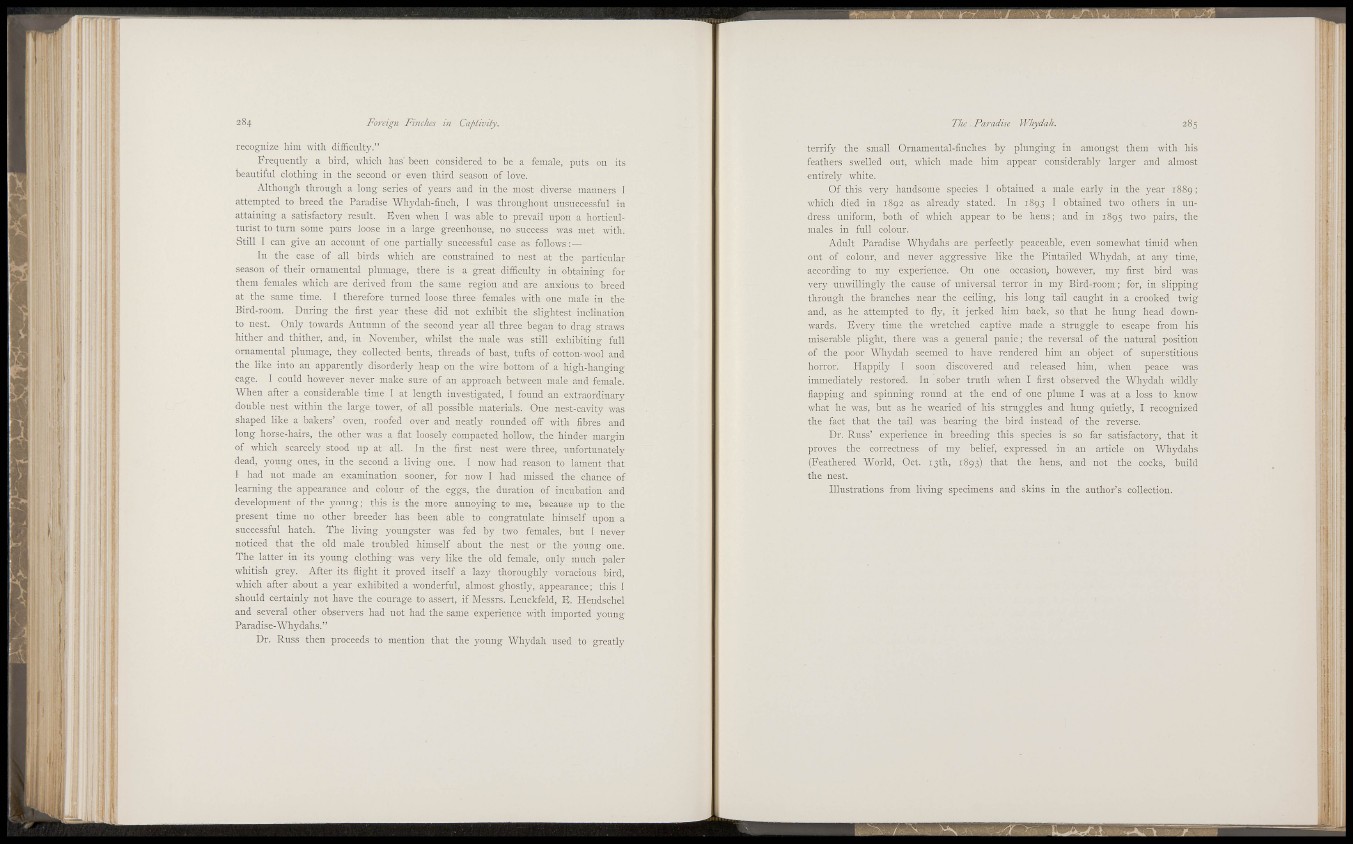
• ' Ì
11 fi;
284 Foreign Finchcs in Caf>fiviiy.
recognize him with difficalt3^"
Frequentl}' a bird, which has' been considered to be a female, puts on its
beautiful clothing in the second or even third season of love.
Although through a long series of 3iears and in the most diverse manners I
attempted to breed the Paradise Whj'dah-finch, 1 was throughout unsuccessful in
attaining a satisfactoiy result. Even when 1 was able to prevail upon a horticulturist
to turn some pairs loose in a large greenhouse, no success was met with.
Still I can give an account of one partially successful case as follows : —
In the case of all birds which are constrained to nest at the particular
season of their ornamental plumage, there is a great diiEcult3r in obtaining for
them females which are derived from the same region and are anxious to breed
at the same time. ! therefore turned loose three females with one male in the
Bird-room. During the first 3^ear these did not exhibit the slightest inclination
to nest. Only towards Autumn of the second year all three began to drag straws
hither and thither, and, in November, whilst the male was still exhibiting full
ornamental plumage, they collected bents, threads of bast, tufts of cotton-wool and
the like into an apparently disorderly heap on the wire bottom of a high-hanging
cage. I could however never make sure of an approach between male and female.
When after a considerable time I at length investigated, I found an extraordinary
double nest within the large tower, of all possible materials. One nest-cavity was
shaped like a bakers' oven, roofed over and neatly rounded off with fibres and
long horse-hairs, the other was a flat loosely compacted hollow, the hinder margin
of which scarcely stood up at all. In the first nest were three, unfortunately
dead, young ones, in the second a living one. 1 now had reason to lament that
I had not made an examination sooner, for now I had missed the chance of
learning the appearance and colour of the eggs, the duration of incubation and
development of the young; this is the more annoying to me, because up to the
present time no other breeder has been able to congratulate himself upon a
successful hatch. The living j'oungster was fed hy two females, but 1 never
noticed that the old male troubled himself about the nest or the young one.
The latter in its young clothing was very like the old female, only much paler
whitish grey. After its flight it proved itself a lazy thoroughly voracious bird,
which after about a year exhibited a wonderful, almost ghostly, appearance; this 1
should certainly not have the courage to assert, if Messrs. Leuckfeld, E. Hendschel
and several other observers had not had the same experience with imported young
Paradise-Whydahs. ' '
Dr. Russ then proceeds to mention that the young Whydah used to greatly
The Paradise Whyelah. 28s
terrify the small Ornamental-finches by plunging in amongst them with his
feathers swelled out, which made him appear considerably larger and almost
entirely white.
Of this very handsome species I obtained a male early in the year 1889;
which died in 1892 as already stated. In 1893 I obtained two others in imdress
uniform, both of which appear to be hens; and in 1895 two pairs, the
males in full colour.
Adult Paradise Whj^dahs are perfectly peaceable, even somewhat timid when
out of colour, and never aggressive like the Pintailed Whydah, at any time,
according to my experience. On one occasion^ however, my first bird was
very unwilling^ the cause of universal terror in my Bird-room ; for, in slipping
through the branches near the ceiling, his long tail caught in a crooked twig
and, as he attempted to fly, it jerked him back, so that he hung head downwards.
Every time the wretched captive made a struggle to escape from his
miserable plight, there was a general panic; the reversal of the natural position
of the poor Whydah seemed to have rendered him an object of superstitious
horror. Happily 1 soon discovered and released him, when peace was
immediately restored. In sober truth when I first obsei-ved the Whydah wildly
flapping and spinning round at the end of one plume I was at a loss to know
what he was, but as he wearied of his struggles and hung quietty, I recognized
the fact that the tail was bearing the bird instead of the reverse.
Dr. Russ' experience in breeding this .species is so far satisfactoi-jr, that it
proves the coi-rectness of my belief, expressed in an article on Whydahs
(Feathered World, Oct. 13th, 1893) that the hens, and not the cocks, btiild
the nest.
Illustrations from living specimens and skins in the author's collection.